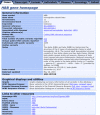LOVD-DASH: A comprehensive LOVD database coupled with diagnosis and an at-risk assessment system for hemoglobinopathies
- PMID: 31286593
- PMCID: PMC6899610
- DOI: 10.1002/humu.23863
LOVD-DASH: A comprehensive LOVD database coupled with diagnosis and an at-risk assessment system for hemoglobinopathies
Abstract
Hemoglobinopathies are the most common monogenic disorders worldwide. Substantial effort has been made to establish databases to record complete mutation spectra causing or modifying this group of diseases. We present a variant database which couples an online auxiliary diagnosis and at-risk assessment system for hemoglobinopathies (DASH). The database was integrated into the Leiden Open Variation Database (LOVD), in which we included all reported variants focusing on a Chinese population by literature peer review-curation and existing databases, such as HbVar and IthaGenes. In addition, comprehensive mutation data generated by high-throughput sequencing of 2,087 hemoglobinopathy patients and 20,222 general individuals from southern China were also incorporated into the database. These sequencing data enabled us to observe disease-causing and modifier variants responsible for hemoglobinopathies in bulk. Currently, 371 unique variants have been recorded; 265 of 371 were described as disease-causing variants, whereas 106 were defined as modifier variants, including 34 functional variants identified by a quantitative trait association study of this high-throughput sequencing data. Due to the availability of a comprehensive phenotype-genotype data set, DASH has been established to automatically provide accurate suggestions on diagnosis and genetic counseling of hemoglobinopathies. LOVD-DASH will inspire us to deal with clinical genotyping and molecular screening for other Mendelian disorders.
Keywords: DASH; LOVD; clinical genotyping; database; hemoglobinopathy; molecular screening.
© 2019 The Authors. Human Mutation Published by Wiley Periodicals, Inc.
Conflict of interest statement
The authors declare that there are no conflict of interest.
Figures


Similar articles
-
[A comprehensive repository of mutation data and a clinical assistant decision system for hemoglobinopathy in the Chinese population].Yi Chuan. 2019 Aug 20;41(8):746-753. doi: 10.16288/j.yczz.19-136. Yi Chuan. 2019. PMID: 31447425 Chinese.
-
Rapid Targeted Next-Generation Sequencing Platform for Molecular Screening and Clinical Genotyping in Subjects with Hemoglobinopathies.EBioMedicine. 2017 Sep;23:150-159. doi: 10.1016/j.ebiom.2017.08.015. Epub 2017 Aug 17. EBioMedicine. 2017. PMID: 28865746 Free PMC article.
-
LOVD v.2.0: the next generation in gene variant databases.Hum Mutat. 2011 May;32(5):557-63. doi: 10.1002/humu.21438. Epub 2011 Feb 22. Hum Mutat. 2011. PMID: 21520333
-
Mutation Update of ARSA and PSAP Genes Causing Metachromatic Leukodystrophy.Hum Mutat. 2016 Jan;37(1):16-27. doi: 10.1002/humu.22919. Epub 2015 Nov 4. Hum Mutat. 2016. PMID: 26462614 Review.
-
Molecular diagnosis of inherited disorders: lessons from hemoglobinopathies.Hum Mutat. 2005 Nov;26(5):399-412. doi: 10.1002/humu.20225. Hum Mutat. 2005. PMID: 16138310 Review.
Cited by
-
Rapid detection of genetic modifiers of β-thalassemia based on MALDI-TOF MS.Ann Hematol. 2025 Mar;104(3):1481-1492. doi: 10.1007/s00277-025-06277-2. Epub 2025 Feb 28. Ann Hematol. 2025. PMID: 40016399 Free PMC article.
-
Establishment and application of a novel method based on single nucleotide polymorphism analysis for detecting β-globin gene cluster deletions.Sci Rep. 2020 Oct 26;10(1):18298. doi: 10.1038/s41598-020-75507-6. Sci Rep. 2020. PMID: 33106596 Free PMC article.
-
A protospacer adjacent motif-free, multiplexed, and quantitative nucleic acid detection platform with barcode-based Cas12a activity.MedComm (2020). 2023 Jul 2;4(4):e310. doi: 10.1002/mco2.310. eCollection 2023 Aug. MedComm (2020). 2023. PMID: 37405277 Free PMC article.
-
A Comprehensive LOVD Database for Fatty Acid Oxidation Disorders in Chinese Populations.Hum Mutat. 2023 Jul 25;2023:5493978. doi: 10.1155/2023/5493978. eCollection 2023. Hum Mutat. 2023. PMID: 40225143 Free PMC article.
-
Unique Polymorphisms at BCL11A, HBS1L-MYB and HBB Loci Associated with HbF in Kuwaiti Patients with Sickle Cell Disease.J Pers Med. 2021 Jun 17;11(6):567. doi: 10.3390/jpm11060567. J Pers Med. 2021. PMID: 34204365 Free PMC article.
References
Publication types
MeSH terms
Grants and funding
- 2017YFC1001800/National Key Research and Development program of China/International
- 2018YFA0507803/National Key Research and Development program of China/International
- NSFC 31671314/National Natural Science Foundation of China/International
- NSFC 81870148/National Natural Science Foundation of China/International
- 201604020045/Science and Technology Program of Guangzhou/International
LinkOut - more resources
Full Text Sources

